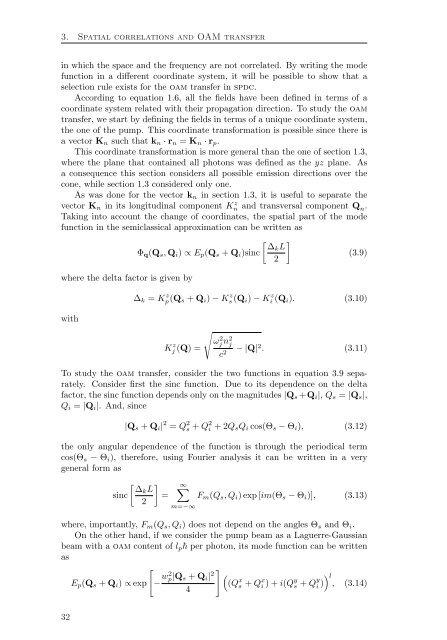Spatial Characterization Of Two-Photon States - GAP-Optique
Spatial Characterization Of Two-Photon States - GAP-Optique
Spatial Characterization Of Two-Photon States - GAP-Optique
You also want an ePaper? Increase the reach of your titles
YUMPU automatically turns print PDFs into web optimized ePapers that Google loves.
3. <strong>Spatial</strong> correlations and OAM transfer<br />
in which the space and the frequency are not correlated. By writing the mode<br />
function in a different coordinate system, it will be possible to show that a<br />
selection rule exists for the oam transfer in spdc.<br />
According to equation 1.6, all the fields have been defined in terms of a<br />
coordinate system related with their propagation direction. To study the oam<br />
transfer, we start by defining the fields in terms of a unique coordinate system,<br />
the one of the pump. This coordinate transformation is possible since there is<br />
a vector Kn such that kn · rn = Kn · rp.<br />
This coordinate transformation is more general than the one of section 1.3,<br />
where the plane that contained all photons was defined as the yz plane. As<br />
a consequence this section considers all possible emission directions over the<br />
cone, while section 1.3 considered only one.<br />
As was done for the vector kn in section 1.3, it is useful to separate the<br />
vector Kn in its longitudinal component Kz n and transversal component Qn. Taking into account the change of coordinates, the spatial part of the mode<br />
function in the semiclassical approximation can be written as<br />
<br />
∆kL<br />
Φq(Qs, Qi) ∝ Ep(Qs + Qi)sinc<br />
(3.9)<br />
2<br />
where the delta factor is given by<br />
with<br />
∆k = K z p(Qs + Qi) − K z s (Qi) − K z i (Qi). (3.10)<br />
K z j (Q) =<br />
<br />
ω 2 j n2 j<br />
c 2 − |Q|2 . (3.11)<br />
To study the oam transfer, consider the two functions in equation 3.9 separately.<br />
Consider first the sinc function. Due to its dependence on the delta<br />
factor, the sinc function depends only on the magnitudes |Qs +Qi|, Qs = |Qs|,<br />
Qi = |Qi|. And, since<br />
|Qs + Qi| 2 = Q 2 s + Q 2 i + 2QsQi cos(Θs − Θi), (3.12)<br />
the only angular dependence of the function is through the periodical term<br />
cos(Θs − Θi), therefore, using Fourier analysis it can be written in a very<br />
general form as<br />
<br />
∆kL<br />
sinc =<br />
2<br />
∞<br />
m=−∞<br />
Fm(Qs, Qi) exp [im(Θs − Θi)], (3.13)<br />
where, importantly, Fm(Qs, Qi) does not depend on the angles Θs and Θi.<br />
On the other hand, if we consider the pump beam as a Laguerre-Gaussian<br />
beam with a oam content of lp per photon, its mode function can be written<br />
as<br />
32<br />
Ep(Qs + Qi) ∝ exp<br />
<br />
− w2 p|Qs + Qi| 2<br />
4<br />
<br />
<br />
(Q x s + Q x i ) + i(Q y s + Q y<br />
i )<br />
l , (3.14)



